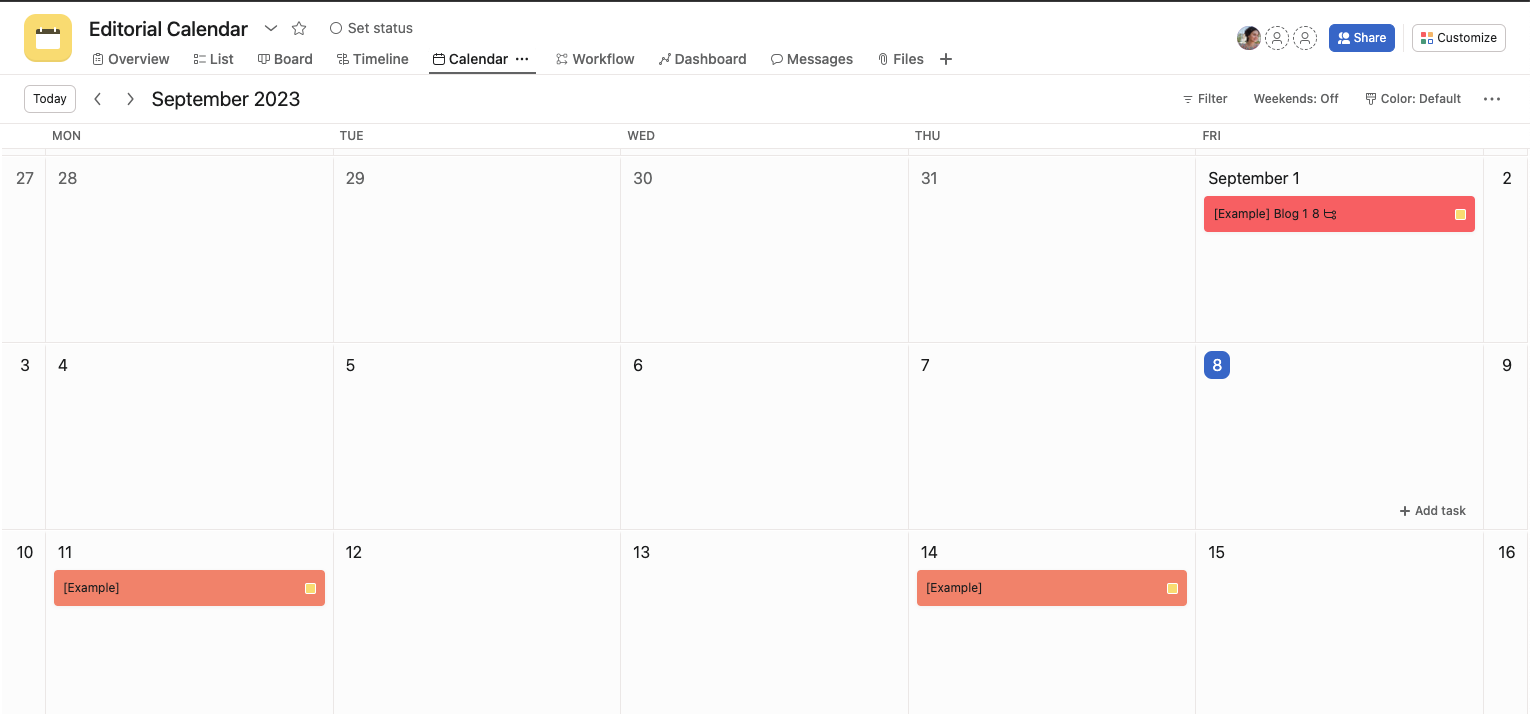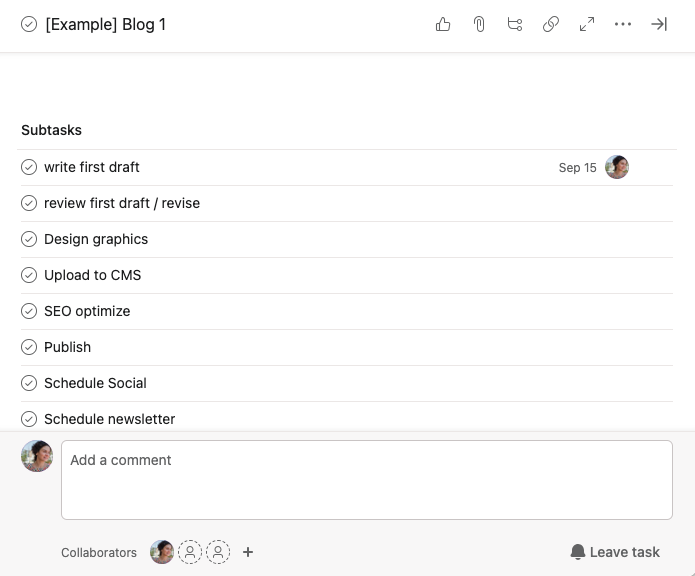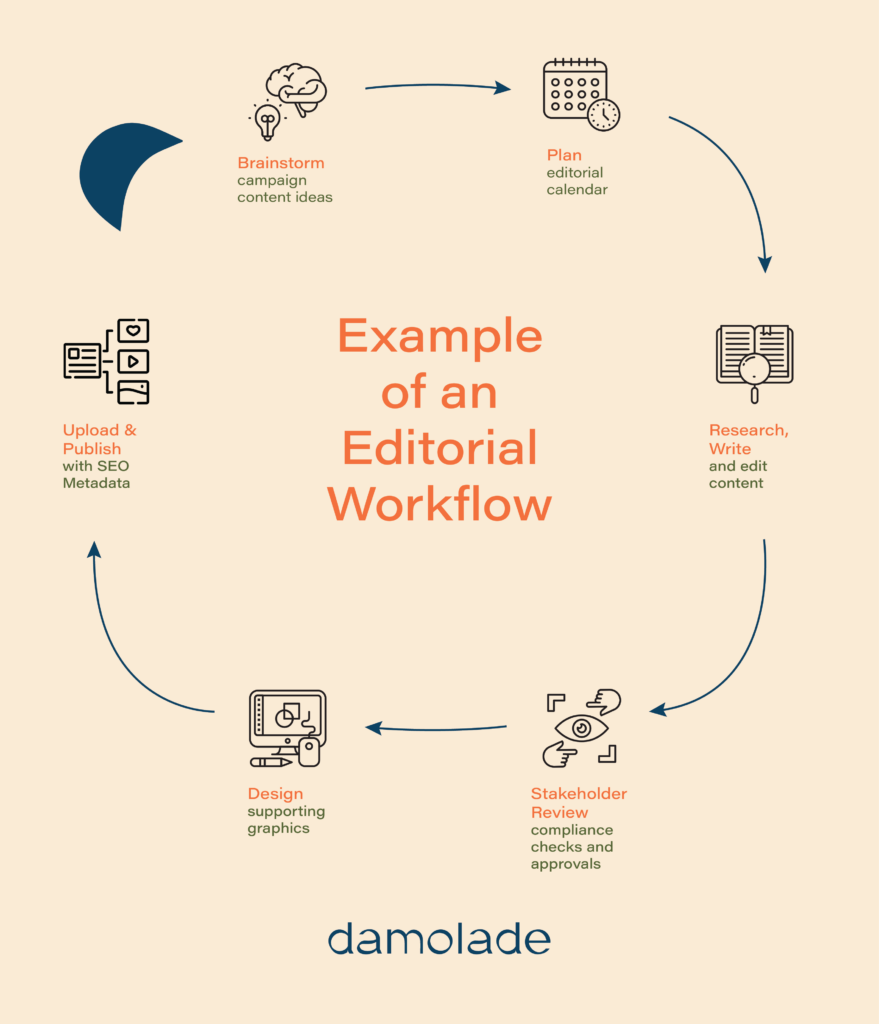
An Effective Editorial Workflow For Your Team
Overview
An editorial workflow is the backbone of content operations. It’s the repeatable system that moves an idea from brainstorm to published asset, complete with reviews for accuracy, compliance, and brand consistency. In damolade’s Tier 3: Transformation package, the workflow powers a “done‑for‑you” content engine that turns one blog post into newsletters, social posts, and landing‑page copy without reinventing the wheel.
Why It Matters
- Accuracy builds trust — subject‑matter reviews and fact‑checks keep errors out of market.
- Regulatory compliance — critical for finance and other tightly regulated sectors.
- Consistent voice — a shared style guide sustains brand identity across channels.
- Speed & efficiency — clear owners and due dates prevent bottlenecks and shorten time‑to‑publish.
RELATED: Republishing Content: Update Old Blog Posts For An SEO Boost
| Step | What Happens | Owner |
| 1. Ideate | Brainstorm topics aligned to quarterly goals and personas; choose hub‑and‑spoke keywords. | Strategist + Stakeholders |
| 2. Plan | Add topics, keywords, and owners to the editorial calendar (Asana). | Project Manager |
| 3. Research | Pull data, quotes, and regulatory guidance. | Writer/Analyst |
| 4. Draft | Write first version following brand style + SEO best practices. | Writer |
| 5. Edit | Check grammar, tone, and structure; verify sources. | Editor |
| 6. Compliance | Confirm alignment with industry regulations and legal team feedback. | Compliance Lead |
| 7. Optimize & Design | Insert graphics, on‑page SEO, and metadata. | Designer + SEO Specialist |
| 8. Publish & Promote | Push live in CMS, then amplify via email and social; log performance KPIs. | Marketing Ops |
Pro Tip: Stick to due dates and keep conversation in one tool (we love Asana) to avoid siloed feedback
The 8‑Step Workflow In Detail
1. Ideate
It starts with brainstorming and idea generation, aligning content with business goals and audience needs. To know what content to create, have a plan for your content with research, messaging, personas, and goals in mind. We recommend creating a one-page plan to get all stakeholders aligned.
If you’re ready to start your editorial planning, our planning spreadsheet is available for download.

During a meeting, we get buy-in from key stakeholders around content that will support business goals for the quarter. This is where having that one-page strategy done ahead of time will come in handy!
For our meeting to be successful, we need to accomplish the following:
- Choose a main service category to focus on for the quarter, such as “non-profit wealth management services.”
- Choose the main topics in that category. Do we want to create highly competitive content on the main topic? Or are we concentrating on less competitive, informational keywords? These informational keywords are known as subtopics.
For example, the topics below are “non-profit organizations,” “cash flow,” and “board of directors.” All of these would have their sub-topics, which are listed beneath the main topics.

Fill in all of this during a call with stakeholders. Our software, SEMRush, uses content marketing tools to find popular and relevant topics for our audience. Now, we have all our topics for the entire quarter that will link to the main category hub page.
2. Plan:

Create a content calendar with topics, deadlines, and responsible team members. This is where an editorial calendar comes into play.
We highly recommend using a project management tool like Asana for this part. It serves as the backbone of the workflow, helping teams plan content production and publication strategically. The editorial calendar should include:
– Content topics and titles.
– Assigned authors and editors.
– Due dates for each stage of the workflow.
– Publication schedule.
– Keywords and SEO strategy.

Customize your tasks and subtasks as appropriate in the workflow.
Pro tips: Stick to due dates! Know who is responsible for it! Communicate amongst departments! Avoid silos!
3. Research:
Gather data, statistics, and information relevant to the topic.
4. Draft:
The designated writer authors the first draft, following style guidelines
5. Edit:
An editor reviews the content for grammar, style, and accuracy.
6. Compliance:
Compliance experts ensure the content meets regulatory standards in the financial sector.
7. Format and Optimize:
Incorporate relevant keywords, graphics, schema, FAQ, and meta tags for search engine and AI optimization.
8. Publish & promote:
Push live in CMS, we have an automation for this here. Amplify via email and social, and track metrics.
For my visual learners:
People & Roles
– Content Creators: Writers and subject matter experts.
– Editor: Ensures quality and consistency.
– Compliance Experts: Ensures adherence to regulatory requirements.
– Management: Approves content and oversees strategy.
– Designers: Enhance visual appeal.
– SEO Specialists: Optimize content for search engines.
Each process step is assigned ownership in Asana with due dates and responsibilities. You will eliminate uncertainty and have a clear step-by-step process for everyone to follow.
Tools We Recommend
– Content Management System (CMS): A content creation and publishing platform.
– Editing Tools: Grammar and style checkers. Get one month of Grammarly free here.
– SEO Tools: Keyword research and optimization tools. We use SEMRush. Ahrefs is also great.
– Analytics Tools: To track content performance.
– Collaboration Software: Facilitates communication among team members. Use a project management system like Asana.
Ready to build yours?
In a single Google Meet session, we can custom-fit this workflow to your team’s size, regulations, and tech stack. Reach out via the contact form below for a free 30-minute consult, during which we will identify three things you can do right now to improve your editorial workflow.



